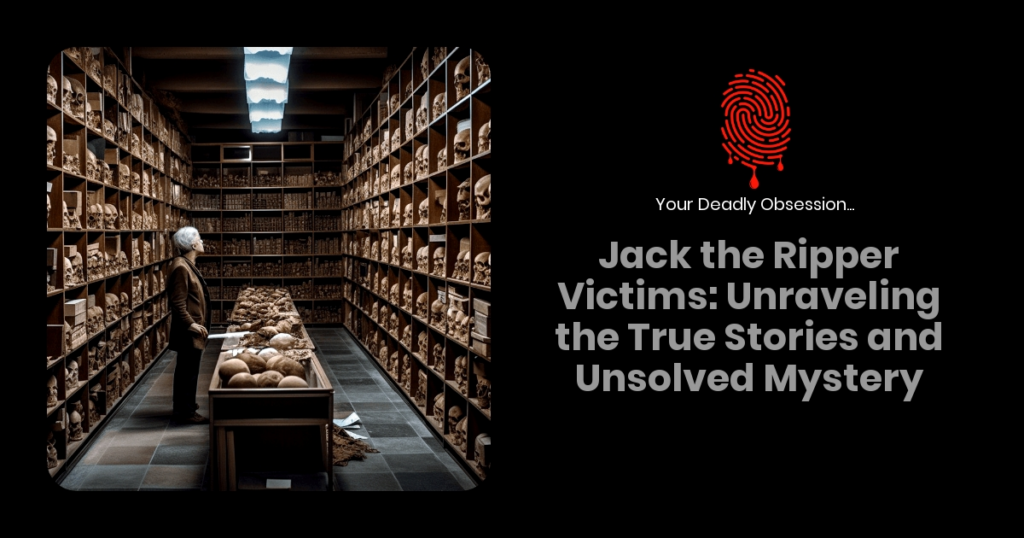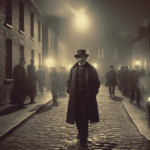Jack the Ripper remains one of history’s most notorious and enigmatic serial killers. The grisly murders attributed to him in the late 1800s have both fascinated and horrified generations. Central to the mystery are the victims, whose tragic stories provide a window into the harsh realities of life in Victorian London. In this article, we’ll delve into the lives and circumstances surrounding these unfortunate women, shedding light on what it meant to be a victim of one of the world’s most infamous killers.

The five women generally acknowledged as Jack the Ripper’s victims are Mary Ann Nichols, Annie Chapman, Elizabeth Stride, Catherine Eddowes, and Mary Jane Kelly. Though there’s ongoing debate among historians and criminologists regarding additional victims, these five women are known as the Canonical Five due to the similarities in the brutal nature of their murders. Understanding who these women were and the context in which they lived can help us gain a more comprehensive picture of the infamous Whitechapel murders.
We’ll examine each victim’s background, circumstances leading up to their untimely deaths, and the impact of their murders on both the investigation and public consciousness during that time. The chilling legacy of Jack the Ripper is intertwined with the stories of these women, as they transform from mere statistics to real people with lives, dreams, and challenges. Their narratives give a disturbingly personal dimension to these gruesome events.
A Peek into the Lives of Jack the Ripper’s Victims
To fully appreciate the terror that gripped London during the late 19th century, it’s essential to understand the lives of Jack the Ripper’s victims. This infamous serial killer targeted women, primarily prostitutes, in the Whitechapel district of London between August and November of 1888.
His five confirmed victims were Mary Ann Nichols, Annie Chapman, Elizabeth Stride, Catherine Eddowes, and Mary Jane Kelly. It’s believed that these women’s vulnerabilities made them easy targets for the Ripper. Let’s delve deeper into their lives before they fell prey to this notorious killer.
Mary Ann Nichols, often referred to as “Polly,” was a mother of five who had been working as a prostitute to make ends meet. She had separated from her husband after she’d had an affair with a man named Thomas Drew. Polly had struggled with alcoholism, frequently sleeping on the streets, and lived in workhouses.
Annie Chapman, a widowed mother of three, turned to prostitution to support herself after the death of her husband, who was a coachman. She also battled alcoholism and, like Polly, found herself in and out of workhouses. Despite her sordid circumstances, she was remembered as a kind and caring person.
Elizabeth Stride, born in Sweden, was married to John Thomas Stride for several years before they separated. Liz, as she was called, had a history of petty crime, prostitution, and alcoholism. It’s said that she coped with the death of her infant daughter by drinking.
Catherine Eddowes, a mother to three children from different partners, had experienced homelessness and poverty throughout her life. Her final years were marked by unstable relationships and extreme vulnerability due to her financial troubles.
Mary Jane Kelly, the youngest of the victims at 25, had left her husband and resort to prostitution. She was known for her beauty and described as a friendly, affectionate person. Her tragic end would not only be the last in the infamous series of murders but also the most brutal.
Jack the Ripper’s choice of victims reflects the vulnerable state of these women – poor, alcoholic, usually desperate for money or shelter. We must remember that behind the grisly details of each murder, there were real human beings with their own stories and struggles.
Life details of the victims:
| Name | Occupation | Personal Struggles |
|---|---|---|
| Mary Ann Nichols | Prostitute | Alcoholism, Homelessness |
| Annie Chapman | Prostitute | Alcoholism, Widow |
| Elizabeth Stride | Prostitute | Alcoholism, Grief |
| Catherine Eddowes | Prostitute | Financial Issues, Unstable Relationships |
| Mary Jane Kelly | Prostitution | Youth, Separation from Husband |
By immersing ourselves in the lives of these women, we can better understand the sinister legacy left behind by Jack the Ripper and the tragedy that befell his victims. As die-hard fans of cold cases, crime, and mystery, it’s crucial never to lose sight of the human element in these grisly histories.
The Dreadful Night of August 31st, 1888
August 31st, 1888 marks the beginning of a terrifying series of events that shook the world to its core. The infamous Jack the Ripper claimed his first known victim that fateful night, starting a chilling murder spree in the Whitechapel district of London.
The first unfortunate soul who fell victim to the Ripper was Mary Ann Nichols. She was 43 years old and had led a troubled life, working as a prostitute to make ends meet. It’s believed that on this dreadful night, she was lured to a dark, secluded spot by her attacker when the grisly crime took place. The brutal nature of her murder set the tone for the violent and terrifying murders that would follow.
The events of that evening are shrouded in mystery, but the timeline for the night goes as follows:
- Around 2:30 am: Nichols was last seen alive, walking east along Whitechapel Road.
- Between 2:30 am and 3:30 am: Nichols’ murder likely took place.
- 3:40 am: Her body was found by a man named Charles Cross in Buck’s Row, a narrow street in Whitechapel.
| Time | Event |
|---|---|
| 2:30 am | Nichols spotted alive |
| 2:30 am-3:30 am | Presumed time of the murder |
| 3:40 am | Body discovered in Buck’s Row |
The horrifying injuries inflicted upon her included:
- Severe slashes to her throat
- A deeply cut abdomen
- Bruises on her face
This night was just the start of the terror that would grip London for months to come. In the following weeks, four other women would meet similar fates, sharing eerily parallel stories to Nichols’:
- Annie Chapman
- Elizabeth Stride
- Catherine Eddowes
- Mary Jane Kelly
As we continue to delve deeper into the story of Jack the Ripper, it is important to remember the victims who faced unimaginable fates. They are the true, tragic centerpieces of this dark chapter in history, which has captivated crime and mystery enthusiasts for centuries.
The Terrifying Double Event: September 30th, 1888
On September 30th, 1888, Jack the Ripper’s violent spree escalated to new heights, as we delve into the night that became infamously known as the Double Event. This horrific night involved two separate murders, which were both attributed to the famed serial killer.
The first of these grisly killings took place in the early hours of the morning, when Elizabeth Stride was found slain. Her corpse was discovered in Dutfield’s Yard, off Berner Street in Whitechapel. Stride, a Swedish immigrant, was working as a prostitute at the time of her death. Her throat had been savagely cut, but unlike other Ripper victims, there were no mutilations to her abdomen. It’s widely believed that the killer was interrupted before he could carry out the full extent of his sadistic ritual.
Here are some key facts about Elizabeth Stride:
- Born in Sweden in 1843
- Worked as a prostitute in London’s East End
- Was found with her neck brutally slashed
The second murder that night involved Catherine Eddowes, who was killed only a few streets from where Stride’s body had been discovered. Eddowes was also a known prostitute, and she met a similar fate to Stride. Her body was found in Mitre Square, with her throat viciously cut and her abdomen grotesquely mutilated. Chillingly, a part of her left kidney and uterus had been removed by her killer.
Catherine Eddowes’ murder shared many similarities with previous Ripper victims:
- Abdominal mutilations
- Throat cut from left to right
- Killed in the early morning hours
The sheer brutality of these killings and the fact that they occurred within hours of each other sent shockwaves throughout London. The close proximity and timing of the murders led investigators to believe that they were indeed the work of the same nefarious individual – Jack the Ripper.
During the investigation of the Double Event, a cryptic message was discovered scrawled on a nearby wall that read: “The Juwes are the men that will not be blamed for nothing“. It’s unclear whether the Ripper penned this message or if it’s merely an unrelated act of vandalism, but its ominous presence only added to the mystery surrounding these vicious crimes.
As we continue to explore the dark tale of Jack the Ripper, here’s a brief recap of the Double Event:
- Two murders within hours of each other
- Both victims were prostitutes
- Elizabeth Stride’s murder was possibly interrupted
- Catherine Eddowes suffered extensive mutilations
The terror of the Double Event will forever haunt our understanding of history’s most infamous killer.
The Brutal Murder of Catherine Eddowes
We’d like to introduce you to Catherine Eddowes, the fourth victim of Jack the Ripper, a serial killer who terrorized London’s East End in the late 1800s. Her murder stands out due to its extreme brutality, gruesome details, and chilling similarities to earlier attacks.
Eddowes’ body was discovered on September 30, 1888, in Mitre Square, a small public square in the Whitechapel district. This location is significant because it connected two major thoroughfares, making it a central point for travelers passing through the area. Jack the Ripper may have targeted this location intentionally, knowing that it would be frequented by strong-willed, street-savvy women.
The scene that awaited investigators was horrifying. Eddowes’ throat had been slashed, and her body brutally mutilated. The following key elements were noted by investigators:
- A deep cut across her throat, severing the windpipe and nearby blood vessels
- Her abdomen sliced open and many internal organs removed
- Cheeks, nose, and eyelids were severely cut, possibly as an act of torture
It was evident that Catherine Eddowes had been subjected to a savage attack that would become a trademark of Jack the Ripper. Though these crimes may have occurred over a century ago, the brutal nature of the murders still resonates with us.
| Victim | Date of Murder | Location Found |
|---|---|---|
| Catherine Eddowes | September 30, 1888 | Mitre Square |
The similarities between Eddowes’ murder and earlier victims only solidified the gruesome link between these cases:
- All victims were women from impoverished backgrounds working in the streets
- Their throats were slashed in the same manner
- The mutilation of their bodies was a constant aspect of each murder
Despite numerous leads and suspicions, the identity of Jack the Ripper was never conclusively discovered, leading to countless theories and conjecture about the killer’s identity. Eddowes’ murder remains just one piece in the chilling puzzle that is Jack the Ripper’s legacy.
In summary, the brutal murder of Catherine Eddowes stands as a stark reminder of the terror that gripped London in the late 19th century. While her death may be over a century old, the haunting details and unanswered questions surrounding the case continue to captivate the minds of crime and mystery enthusiasts worldwide.
The Mysterious Death of Mary Jane Kelly
Out of all of Jack the Ripper’s victims, the death of Mary Jane Kelly stands as the most gruesome and enigmatic. Kelly’s murder took place on November 9, 1888, marking the fifth and final known killing attributed to the notorious figure. What sets her case apart is the extent of the mutilation, and the fact that her body was discovered indoors, offering a much different crime scene than the previous murders.
Mary Jane Kelly was just 25 years old at the time of her death, making her the youngest of the Ripper’s victims. She was found by her landlord, John McCarthy, in her room at 13 Miller’s Court, located in the heart of Whitechapel. An accomplished artist by the name of Joseph Barnett, Kelly’s former boyfriend, was also present at the scene.
| Victim | Age | Date of Death | Location |
|---|---|---|---|
| Mary Jane Kelly | 25 | November 9, 1888 | 13 Miller’s Court, Whitechapel |
Here’s what we know about the night of her murder:
- Kelly was last seen alive on the early hours of November 9th.
- She was accompanied by a man wearing a long coat and carrying a small parcel.
- A neighbor reportedly heard a cry of “Murder!” at around 4:00 AM, but did not investigate due to the frequency of such exclamations in the area.
The crime scene was nothing short of horrific. Kelly’s body had been severely mutilated, with her face almost unrecognizable. Her abdominal cavity was emptied, and her organs were placed near her body. The extensive damage left many wondering what drove the killer to commit such a barbaric act.
Several theories attempt to explain why Mary Jane Kelly’s death was different from the others:
- The indoor location may have provided the killer with more time to perform the gruesome mutilations,uninterrupted.
- Kelly’s young age and status as a professional artist may have triggered a stronger emotional response from the killer.
- Some speculate that the murderer knew her personally, thus leading to increased aggression towards Kelly.
Despite these theories, the truth behind Mary Jane Kelly’s tragic death remains elusive, and more than a century later, her case remains one of the darkest chapters in the infamous tale of Jack the Ripper.
Understanding the Victims’ Impact on the Investigation
When studying the infamous Jack the Ripper case, it’s crucial to consider the impact the victims had on the investigation. The five victims, known as the Canonical Five, were:
- Mary Ann Nichols
- Annie Chapman
- Elizabeth Stride
- Catherine Eddowes
- Mary Jane Kelly
Given the similarities in their backgrounds, individual circumstances, and the manner of their grisly deaths, these women played a central role in shaping the overall direction of the investigation.
At the time, the murders were connected because the victims shared several characteristics: they were all prostitutes, they were of a similar age, and they all belonged to the lower socio-economic class. Due to these factors, investigators initially focused on suspects who potentially held grudges against prostitutes or had histories of violence against women.
| Victim | Age | Profession | M.O. of Murder |
|---|---|---|---|
| Mary Ann Nichols | 43 | Prostitute | Slashed throat, abdominal mutilation |
| Annie Chapman | 47 | Prostitute | Slashed throat, abdominal mutilation |
| Elizabeth Stride | 44 | Prostitute | Slashed throat |
| Catherine Eddowes | 46 | Prostitute | Slashed throat, abdominal mutilation, facial mutilation |
| Mary Jane Kelly | 25 | Prostitute | Slashed throat, extreme mutilation of body and face |
Another critical aspect was the close proximity of the murders. Most of the crimes took place within a small area of Whitechapel, which ultimately led investigators to believe that the killer was familiar with the area.
Unfortunately, the investigation faced several challenges, most notably limited forensic technology and resources available at the time. This made it difficult to gather sufficient evidence to conclusively identify a suspect. Additionally, the high levels of crime and poverty in Whitechapel made it likely that any clues found could have been contaminated or lost entirely.
Despite these challenges, the victims were the driving force behind the entire investigation. Their tragic circumstances allowed investigators to piece together a profile of the killer and identify key patterns in the crimes. This information subsequently led them to focus on specific suspects.
While the identity of Jack the Ripper remains a mystery, examining the impact of the victims on the investigation provides valuable insights into the methods and limitations of law enforcement during the Victorian era. By understanding these factors, we can appreciate the complexity of this notorious unsolved case and our continuous fascination with it.
What did Jack the Ripper do with the organs?

Jack the Ripper is infamous for the brutal mutilation of his victims, often removing their organs during the murders. The killer’s intentions for these organs remain a mystery, as they were never recovered or accounted for, fueling speculation and various theories about his motives.
How did Jack the Ripper kill his victims?
Jack the Ripper primarily targeted female prostitutes, killing them by slashing their throats and then mutilating their bodies. He often removed internal organs, indicating a level of anatomical knowledge and suggesting that the killer may have had some surgical skill or experience.
Conclusion: Remembering the Lives Lost
We have delved deep into the world of Jack the Ripper, exploring the mysteries and tragedies that surround one of history’s most notorious serial killers. Let’s take a moment to remember and honor the lives lost during this time.
- Mary Ann Nichols: On August 31st, 1888, Nichols was found with her throat cut and several abdominal wounds. It’s said she was the first victim of Jack the Ripper.
- Annie Chapman: A month later, on September 8th, Chapman suffered similar injuries. She was found with her throat cut, and her abdomen had been savagely torn open.
- Elizabeth Stride: On September 30th, Stride’s body was discovered with her throat slashed. Her murder took place on the same night as Catherine Eddowes.
- Catherine Eddowes: Also murdered on September 30th, Eddowes’ throat was cut, and her stomach was brutally mutilated. Her left kidney and part of her uterus were removed.
- Mary Jane Kelly: She was found on November 9th in her own room, victim to the most dreadful and gruesome attack of them all. Kelly’s entire body had been brutally mutilated.
The five women above are known as the “Canonical Five,” believed to be the verified victims of Jack the Ripper. However, there may have been more victims that were never conclusively linked to the killer. Here are a few others who could have also fallen prey to this notorious murderer:
- Emma Elizabeth Smith: On April 3rd, 1888, Smith was assaulted and left for dead. She survived the attack but succumbed to her injuries the following day.
- Martha Tabram: Found dead on August 7th, 1888, Tabram suffered brutal stab wounds. Some investigators believe she was also a victim of the Ripper.
As we reflect on these tragic events, our hearts go out to the innocent lives lost over a century ago. Despite the passage of time, these victims continue to captivate and intrigue cold case enthusiasts, true crime fanatics, and researchers alike. We must continue to seek answers and strive for justice, so that the lives of these women may never be forgotten.
References:

Owner & entrepreneur with a passion for murder mystery! Seriously, who doesn’t love murder mystery?
Chris is a proud member of the American Medical Writer’s Association (AMWA), the International Society for Medical Publication Professionals (ISMPP), the National Association of Science Writers (NASW), the Council of Science Editors, the Author’s Guild, and the Editorial Freelance Association (EFA).

